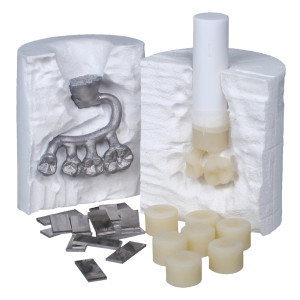Using Z4 Investment with e.max Press
06/24/2013
We often get asked how well Z4 Investment works with lithium disilicate pressable ceramic systems. Our response is yes, Z4 is the perfect investment for all types of pressings systems, including lithium disilicate material such as e.max Press. Many characteristics of Z4 Investment make it a great choice for today's generation of pressable ceramics.
- When Z4 is mixed it has a very fluid consistency that allows rings to be poured with very little, and in some cases no vibration. This results in a bubble-free mold that will deliver accurate pressings.
- Once the ring is poured, and after the necessary setup time has passed, the ring can be placed directly into a hot furnace or it can be placed into a cool furnace. In fact the ring can sit on the bench for hours, days, or weeks and still placed directly into a hot furnace. While most labs don't have rings sitting around for weeks at a time, there are times when an invested ring may need to sit overnight before burnout. With Z4 there is no worry about the timing, because once the bench set time has passed anything is possible.
- Z4 is strong and it can withstand the pressure in the pressing furnace. This means technicians can avoid rings that crack or split with no explanation.
- While Z4 is very strong, when it comes time to devest the pressing it is a simple task. Technicians will not have to use higher pressures and larger amounts of blasting media to retrieve their restoration.
While these values hold true regardless of the type of pressable ceramic in use, when it comes to lithium disilicate materials labs want to know about the "reaction layer". While Z4 is engineered to minimize the reaction layer the thickness or amount of the reaction layer is dependent on many factors outside of the investment that is used.
Our internal research, as well as user feedback, have shown us that the pressing furnace the dental laboratory uses can have perhaps the greatest impact on the reaction layer. Older furnaces can typically require users to estimate the pressing time and also require frequent calibration to achieve a consistent temperature, both of these things can lead to a heavier reaction layer. The newer "automatic" pressing furnaces that are able to sense when the investment mold is filled will only press as long as required to complete the process. By keeping the pressing time to a minimum the ceramic material is not subjected excessive heat and the reaction layer is minimized.

While newer furnaces tend to require less user interaction to deliver high quality results, it is entirely possible to achieve these results with older pressing furnaces. However, many labs are finding that the time and material required to achieve the desired results outweigh the cost of upgrading their equipment.
So does Z4 work well with today's high performance pressable ceramic materials such as e.max Press? We think that the thousands of users across the world would answer with a resounding yes!
Want to try Z4 Investment in your dental laboratory? Just request a free sample and we'll send you a trial kit today.
